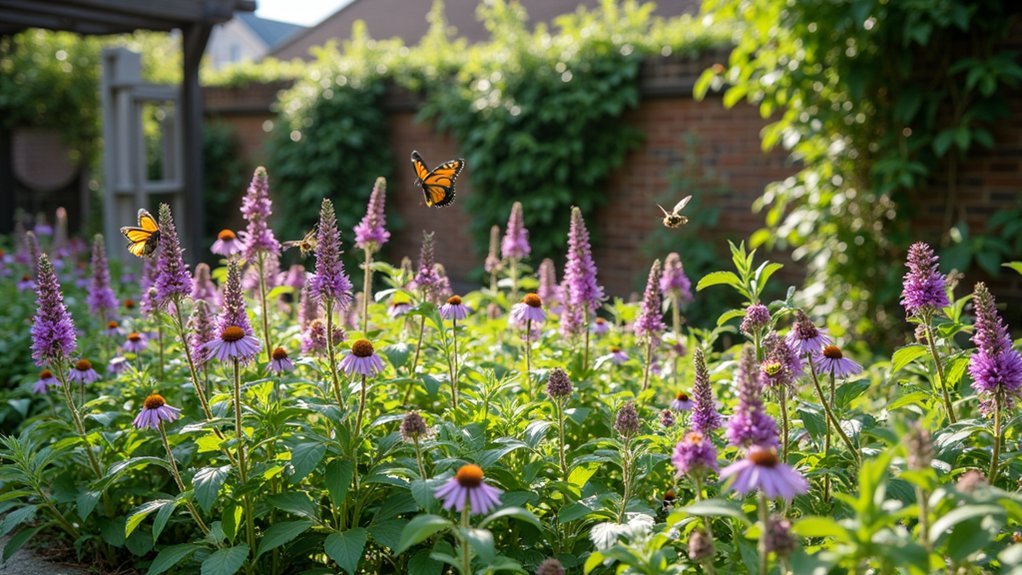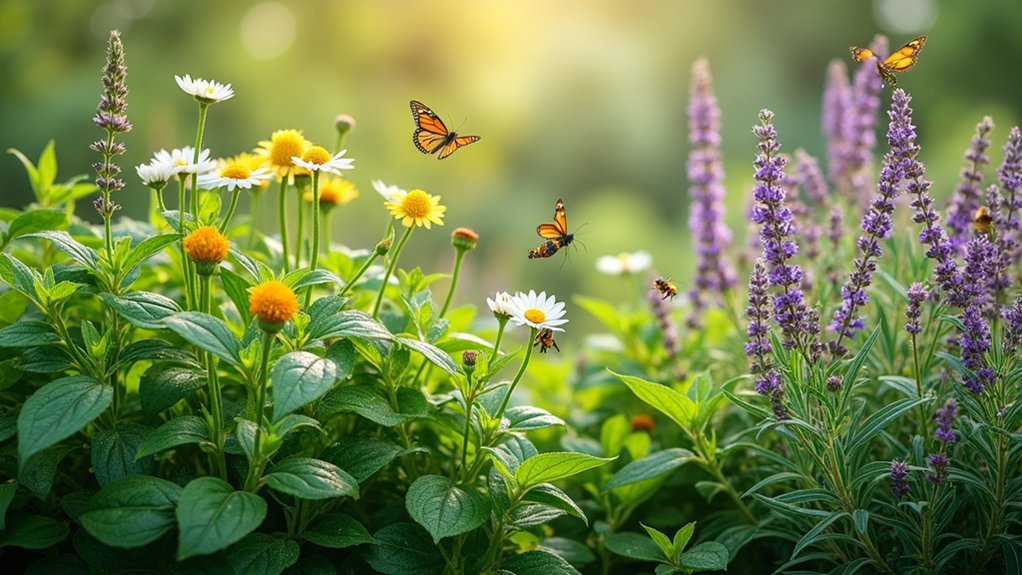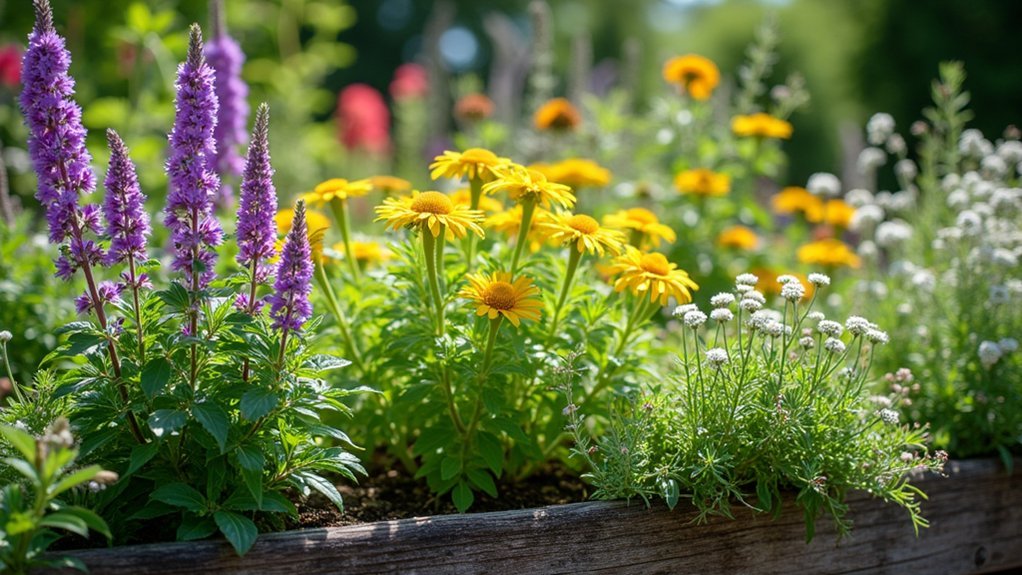The best native herb gardens for local pollinators feature clusters of nectar-rich plants like Lemon Bee Balm, Narrowleaf Mountain Mint, Butterfly Weed, Narrow-leaf Coneflower, and Anise Hyssop. You'll want to create succession plantings that bloom from spring through fall, ensuring continuous food sources. Combine culinary herbs with medicinal varieties to serve dual purposes. Establish garden corridors in urban settings and consider joining community networks for greater impact. The following designs will transform your space into a buzzing pollinator haven.
Creating Urban Herb Corridors for Native Pollinators

As urban environments continue to expand, creating dedicated herb corridors provides vital lifelines for native pollinators searching for food and shelter.
You'll find native plants like Lemon Bee Balm and Narrowleaf Mountain Mint are perfect additions, offering abundant nectar and pollen resources.
Plant these herbs in clusters rather than scattered individuals—this dramatically increases their visibility to passing pollinators and boosts visitation rates.
Design your corridor with blooms appearing throughout the growing season to guarantee continuous food availability.
Beyond nutrition, these spaces offer significant habitat elements. Undisturbed areas provide nesting opportunities for solitary bees, while diverse vegetation creates protective shelter.
Don't hesitate to involve neighbors in your planting efforts—community participation builds environmental stewardship and expands pollinator support networks throughout urban landscapes.
Designing Multi-Season Herb Gardens for Year-Round Support
While many gardeners focus on summer blooms, creating a truly supportive pollinator garden requires thoughtful planning across all seasons.
You'll want to incorporate native plant species that flower successively throughout the year to provide continuous nectar and pollen sources.
Start with early bloomers like Lemon Bee Balm for spring pollinators, then shift to summer-flowering herbs.
Succession planting isn't just for vegetables—it's the secret to keeping pollinators well-fed from frost to frost.
Include Narrowleaf Mountain Mint for late-season support when other food sources diminish.
Plant these herbs in clusters rather than individually to increase visibility and accessibility for pollinators.
Don't forget to mix flowering herbs with non-flowering plants to create a diverse ecosystem.
Include Narrow-leaf Coneflower, which serves dual purposes by attracting adult pollinators while providing essential habitat for butterfly and moth caterpillars.
This thoughtful design guarantees your garden supports pollinators through their complete lifecycle.
Combining Culinary and Medicinal Herbs for Maximum Pollinator Attraction

Creating a dual-purpose herb garden offers remarkable benefits for both your kitchen and local pollinators. When you plant basil, oregano, and thyme, you're not just enhancing your meals—you're providing essential nectar sources for bees and butterflies.
Include medicinal powerhouses like echinacea for immune support and lavender for relaxation. These plants are pollinator magnets while serving your wellness needs.
Strategically selecting herbs that bloom in different months guarantees continuous food availability throughout the growing season.
Don't overlook the importance of native plant species like Monarda (Bee Balm), which are perfectly adapted to local pollinators' needs.
Add dill and fennel as host plants for beneficial insects—swallowtail butterflies will lay eggs on these herbs, supporting their life cycle while providing your kitchen with fresh flavors.
Community-Based Herb Garden Networks: Strength in Numbers
The impact of individual herb gardens grows exponentially when neighbors join forces through community-based networks. By collaborating with fellow gardeners, you'll cultivate a wider diversity of native plant species that attract and sustain local pollinators throughout the growing season.
These networks offer valuable opportunities to share resources, exchange knowledge, and participate in educational workshops about native herbs and their importance to pollinator conservation. You'll learn how to strategically plant varieties with overlapping bloom periods, ensuring continuous nectar sources for bees and butterflies.
Beyond gardening benefits, you'll develop meaningful connections with like-minded individuals committed to environmental stewardship. Together, you'll create larger, more effective habitats that support biodiversity while advocating for sustainable practices that protect your local ecosystem's delicate balance.
Native Herb Species That Thrive in Urban Environments

Five remarkable native herb species have proven their adaptability to the challenges of urban environments, making them perfect choices for city gardeners supporting pollinators. You'll find these native plant species not only beautify your space but also create essential habitat for local wildlife.
| Herb Species | Pollinator Benefits |
|---|---|
| Lemon Bee Balm | Provides nectar throughout growing season |
| Narrowleaf Mountain Mint | Attracts diverse beneficial insects |
| Butterfly Weed | Supports monarch caterpillars and adults |
Drought-tolerant Narrow-leaf Coneflower draws bees and butterflies, while White Prairie Clover improves your soil health. For dual-purpose planting, try Anise Hyssop—it's delicious in teas and irresistible to hummingbirds and bees. These adapted natives require less maintenance while maximizing ecological impact in limited urban spaces.
Sustainable Maintenance Practices for Pollinator Herb Gardens
Maintaining your native herb garden sustainably transforms it from a simple planting to a thriving pollinator sanctuary.
Embrace organic practices by composting and using natural pest controls to create a chemical-free haven for bees and butterflies visiting your native plant species.
Regularly deadhead spent flowers to encourage continuous blooming, extending nectar availability throughout the growing season.
Instead of spacing herbs individually, cluster them in groups to create visually attractive pollinator hotspots.
Incorporate diverse native plant species like basil, oregano, and thyme with staggered blooming periods to provide consistent food sources for various pollinators.
Don't forget to apply a layer of mulch around your herbs—it conserves moisture, suppresses weeds, and creates habitat for beneficial insects that support your garden's pollinator-friendly ecosystem.
Tracking and Documenting Pollinator Activity in City Herb Networks

Successful urban pollinator gardens become even more valuable when you monitor which winged visitors they attract. By documenting pollinator activity in your herb network, you'll identify which native plant species create the most buzz in your urban ecosystem.
| Documentation Method | Benefits |
|---|---|
| Citizen science apps | Contributes to larger datasets |
| Weekly photo logs | Tracks seasonal patterns |
| School monitoring | Builds community engagement |
| Species counts | Informs future planting plans |
Consider organizing community monitoring events where neighbors can learn to identify different pollinators. Data you collect helps urban planners create interconnected pollinator corridors throughout cities. You'll also notice when certain herbs bloom, attracting different species throughout the growing season. This knowledge enables you to maintain continuous pollinator support in your garden year-round.
Frequently Asked Questions
What Herbs Are Good for Pollinators in the Garden?
You'll attract pollinators with lavender, thyme, lemon bee balm, sage, dill, and fennel. These herbs provide nectar, pollen, and habitat for bees, butterflies, and hummingbirds. Plant them in clusters for maximum effectiveness.
What Plants Are Best for a Pollinator Garden?
You'll want milkweed, coneflowers, bee balm, and white prairie clover for your pollinator garden. Plant them in clusters with varied blooming times to support bees and butterflies throughout the growing season.
Are Native Plants Better for Pollinators?
Yes, native plants are better for pollinators. You'll attract more diverse pollinators with native species because they've evolved together. Local insects recognize these plants and can better utilize their nectar and pollen resources.
Are Hydrangeas Good for Pollinators?
Hydrangeas aren't particularly good for pollinators. While they'll attract some bees, they don't provide rich nectar or pollen resources. You'll better support pollinators by including diverse native flowering plants in your garden alongside them.
In Summary
You've now got everything you need to create a thriving native herb garden that supports local pollinators. By selecting appropriate plants, designing for multi-season blooming, and implementing sustainable practices, you're not just growing herbs—you're creating essential habitat. Connect with your community to expand these green corridors, and don't forget to document the pollinators you attract. Your garden matters more than you know.





Leave a Reply